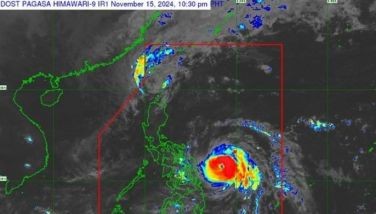Salamat: From librarian to rebel
August 6, 2003 | 12:00am
Muslim rebel chief Hashim Salamat, who died amid moves to restart peace talks with the government, was a humble government librarian before spearheading the biggest Filipino Muslim separatist group’s bloody struggle.
His death — from natural causes according to his organization — on July 13 at the age of 61 was only publicly announced on Tuesday, to allow for a smooth transition and to avoid hurting morale within his 12,500-strong Moro Islamic Liberation Front (MILF.)
Salamat was originally due to sign the final peace agreement that was expected to emerge from scheduled peace talks between the government and the MILF separatists.
He was born to an influential, religious family in Maguindanao province in the southern island of Mindanao, regarded as the ancestral home of the country’s Muslim minority.
The migration of large numbers of Christians over decades had made the Muslims a minority in most parts of the south, fueling the Muslim resentment.
However Salamat was not originally a part of the armed Muslim groups that battled Christians in the south. He had worked as the librarian in his town of Pagalungan.
In the 1960s, he was sent to Egypt where he obtained an Islamic philosophy degree from Al Azhar college in 1967 and a masters degree two years later.
He was also active in groups opposed to then President Ferdinand Marcos and was radicalized by Marcos’ growing strong-arm policies.
Salamat was due to receive a doctoral degree but he chose instead to return to the Philippines to organize the main Muslim separatist group, the Moro National Liberation Front (MNLF) under the leadership of another student activist, Nur Misuari.
Although he had very little military training himself, he was credited with arranging the training of the first batch of MNLF fighters who would wage a bloody guerrilla war for a separate Islamic state in the south in the 1970s.
Salamat served as vice chairman of Misuari until 1978 when he and other fighters broke away from the MNLF to form the MILF.
Misuari had wanted a politically oriented campaign while Salamat was pressing for more radical action to create a purely Islamic state.
Salamat has said there was an ethnic angle involved as well. Misuari’s MNLF had been dominated by members of his Muslim tribe, the Tausugs, while Salamat and his followers were mainly from the Maranao and Maguindanaoan tribes.
While Misuari’s MNLF went on to sign a peace accord with the government in 1996, Salamat’s MILF would go on fighting, occupying huge camps in central Mindanao.
The government accused the MILF of sheltering bandit groups and of forging ties with both local and foreign terrorists like the Jemaah Islamiyah (JI.)
In the late-1990s, the military began overrunning key MILF camps, at one point even bombarding Salamat’s personal residence in 2000. The MILF chairman Salamat was forced to go on the run, moving from one jungle base to another. – AFP
His death — from natural causes according to his organization — on July 13 at the age of 61 was only publicly announced on Tuesday, to allow for a smooth transition and to avoid hurting morale within his 12,500-strong Moro Islamic Liberation Front (MILF.)
Salamat was originally due to sign the final peace agreement that was expected to emerge from scheduled peace talks between the government and the MILF separatists.
He was born to an influential, religious family in Maguindanao province in the southern island of Mindanao, regarded as the ancestral home of the country’s Muslim minority.
The migration of large numbers of Christians over decades had made the Muslims a minority in most parts of the south, fueling the Muslim resentment.
However Salamat was not originally a part of the armed Muslim groups that battled Christians in the south. He had worked as the librarian in his town of Pagalungan.
In the 1960s, he was sent to Egypt where he obtained an Islamic philosophy degree from Al Azhar college in 1967 and a masters degree two years later.
He was also active in groups opposed to then President Ferdinand Marcos and was radicalized by Marcos’ growing strong-arm policies.
Salamat was due to receive a doctoral degree but he chose instead to return to the Philippines to organize the main Muslim separatist group, the Moro National Liberation Front (MNLF) under the leadership of another student activist, Nur Misuari.
Although he had very little military training himself, he was credited with arranging the training of the first batch of MNLF fighters who would wage a bloody guerrilla war for a separate Islamic state in the south in the 1970s.
Salamat served as vice chairman of Misuari until 1978 when he and other fighters broke away from the MNLF to form the MILF.
Misuari had wanted a politically oriented campaign while Salamat was pressing for more radical action to create a purely Islamic state.
Salamat has said there was an ethnic angle involved as well. Misuari’s MNLF had been dominated by members of his Muslim tribe, the Tausugs, while Salamat and his followers were mainly from the Maranao and Maguindanaoan tribes.
While Misuari’s MNLF went on to sign a peace accord with the government in 1996, Salamat’s MILF would go on fighting, occupying huge camps in central Mindanao.
The government accused the MILF of sheltering bandit groups and of forging ties with both local and foreign terrorists like the Jemaah Islamiyah (JI.)
In the late-1990s, the military began overrunning key MILF camps, at one point even bombarding Salamat’s personal residence in 2000. The MILF chairman Salamat was forced to go on the run, moving from one jungle base to another. – AFP
BrandSpace Articles
<
>
- Latest
- Trending
Trending
Latest


























